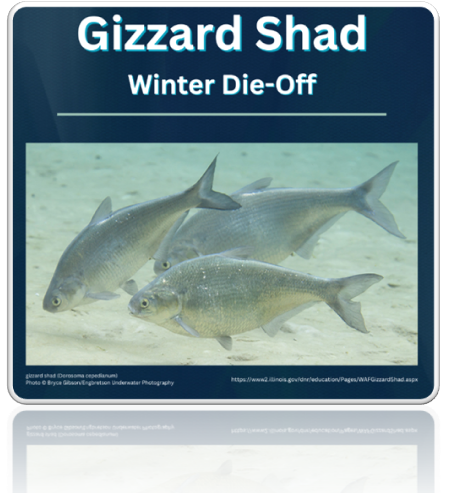 Gizzard Shad
Gizzard Shad
– Winter Die-Off
Gizzard Shad first showed up in the Chain in 2007 and has since expanded to include several-year classes. This isn’t the first-time larger gizzard shad (10″ to 14″ fish) have experienced a die-off following winter and these events are now regular occurrences and can be expected in the future. There are no agencies or organizations that pick up dead fish. When fish kills occur in smaller lakes sometimes the lake owner contracts with landscape crews to remove the dead fish but in the Chain, that isn’t an option. The best course of action is to either let the fish decompose on their own or you can dispose of them in your regular garbage pickup.
The seagulls and eagles have been feasting on dead gizzard shad for a couple of weeks and will continue to do so until the situation ends. The northern part of the Chain usually has the worst die-offs because of their deeper depths and thus can “hold” more of these schooling fish than the shallower lakes. There are still lots of smaller shad present to feed our game fish so although this situation looks dramatic, large shad, small shad, and medium shad still exist in the system and those fish will grow to replace anything that has died this spring. Rarely do these events impact an entire population.
When a certain size of a single species of fish dies, it’s usually related to overabundance. Overabundance causes fish of that size group to be thinner than they should be and the fish are more susceptible to natural mortality from bacterial/viral infections (just like people), changes in the environment (quick temperature changes – as it rains in the middle of winter) or low oxygen in either the heat of summer or worse part of winter. The bottom line is – old fish can die and
regularly do!
Frank Jakubicek
IDNR – District Fisheries Biologist
For more information please visit…
or

 Gizzard Shad
Gizzard Shad